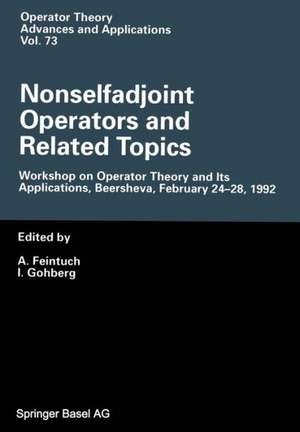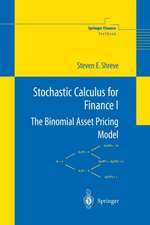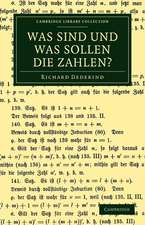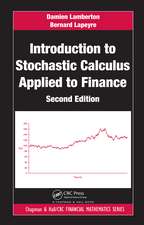Nonselfadjoint Operators and Related Topics: Workshop on Operator Theory and Its Applications, Beersheva, February 24–28, 1992: Operator Theory: Advances and Applications, cartea 73
Editat de A. Feintuch, I. Gohbergen Limba Engleză Paperback – noi 2012
| Toate formatele și edițiile | Preț | Express |
|---|---|---|
| Paperback (1) | 399.67 lei 6-8 săpt. | |
| Birkhäuser Basel – noi 2012 | 399.67 lei 6-8 săpt. | |
| Hardback (1) | 595.36 lei 6-8 săpt. | |
| Birkhauser – 25 aug 1994 | 595.36 lei 6-8 săpt. |
Din seria Operator Theory: Advances and Applications
- 18%
 Preț: 890.54 lei
Preț: 890.54 lei - 20%
 Preț: 574.08 lei
Preț: 574.08 lei - 18%
 Preț: 1127.60 lei
Preț: 1127.60 lei - 15%
 Preț: 643.34 lei
Preț: 643.34 lei - 18%
 Preț: 961.55 lei
Preț: 961.55 lei -
 Preț: 395.63 lei
Preț: 395.63 lei - 15%
 Preț: 648.05 lei
Preț: 648.05 lei - 18%
 Preț: 737.71 lei
Preț: 737.71 lei - 15%
 Preț: 653.14 lei
Preț: 653.14 lei -
 Preț: 384.48 lei
Preț: 384.48 lei - 15%
 Preț: 644.82 lei
Preț: 644.82 lei - 15%
 Preț: 645.79 lei
Preț: 645.79 lei -
 Preț: 402.00 lei
Preț: 402.00 lei - 15%
 Preț: 650.04 lei
Preț: 650.04 lei - 15%
 Preț: 660.83 lei
Preț: 660.83 lei - 15%
 Preț: 639.08 lei
Preț: 639.08 lei - 18%
 Preț: 940.09 lei
Preț: 940.09 lei - 15%
 Preț: 648.05 lei
Preț: 648.05 lei -
 Preț: 388.90 lei
Preț: 388.90 lei - 18%
 Preț: 728.11 lei
Preț: 728.11 lei - 20%
 Preț: 574.08 lei
Preț: 574.08 lei - 15%
 Preț: 645.79 lei
Preț: 645.79 lei - 18%
 Preț: 1128.89 lei
Preț: 1128.89 lei - 15%
 Preț: 646.11 lei
Preț: 646.11 lei - 15%
 Preț: 648.89 lei
Preț: 648.89 lei - 18%
 Preț: 745.33 lei
Preț: 745.33 lei - 18%
 Preț: 1124.47 lei
Preț: 1124.47 lei - 15%
 Preț: 647.08 lei
Preț: 647.08 lei - 15%
 Preț: 662.62 lei
Preț: 662.62 lei -
 Preț: 392.75 lei
Preț: 392.75 lei - 18%
 Preț: 960.96 lei
Preț: 960.96 lei - 15%
 Preț: 646.43 lei
Preț: 646.43 lei - 18%
 Preț: 738.37 lei
Preț: 738.37 lei
Preț: 399.67 lei
Nou
Puncte Express: 600
Preț estimativ în valută:
76.48€ • 80.22$ • 63.67£
76.48€ • 80.22$ • 63.67£
Carte tipărită la comandă
Livrare economică 01-15 aprilie
Preluare comenzi: 021 569.72.76
Specificații
ISBN-13: 9783034896634
ISBN-10: 3034896638
Pagini: 436
Ilustrații: X, 422 p.
Dimensiuni: 170 x 244 x 23 mm
Greutate: 0.69 kg
Ediția:Softcover reprint of the original 1st ed. 1994
Editura: Birkhäuser Basel
Colecția Birkhäuser
Seria Operator Theory: Advances and Applications
Locul publicării:Basel, Switzerland
ISBN-10: 3034896638
Pagini: 436
Ilustrații: X, 422 p.
Dimensiuni: 170 x 244 x 23 mm
Greutate: 0.69 kg
Ediția:Softcover reprint of the original 1st ed. 1994
Editura: Birkhäuser Basel
Colecția Birkhäuser
Seria Operator Theory: Advances and Applications
Locul publicării:Basel, Switzerland
Public țintă
ResearchCuprins
Joint spectrum and discriminant varieties of commuting nonselfadjoint operators.- 1. Introduction.- 2. Joint spectra of commuting operators with compact imaginary parts.- 3. Colligations and vessels.- 4. The discriminant varieties.- References.- On the differential structure of matrix-valued rational inner functions.- 1. Introduction and preliminaries.- 2. The differential structure of Inp.- 3. Charts using Schur algorithm.- 4. Conclusion.- References.- Conservative dynamical systems and nonlinear Livsic-Brodskii nodes.- 1. Conservative systems.- 2. Nonlinear Livsic-Brodskii nodes: models for a given dynamics up to energy preserving diffeomorphic change of variable.- 3. Other partionings of the cast of characters into knowns and unknowns.- References.- Orthogonal polynomials over Hilbert modules.- 1. Introduction.- 2. Orthogonalization with invertible squares.- 3. Preliminaries on inertia theorems for unilateral shifts.- 4. The main result.- References.- Relations of linking and duality between symmetric gauge functions.- 1. Introduction.- 2. Linked symmetric gauge functions.- 3. Quotient of symmetric gauge functions.- 4. Q-norms.- References.- Julia operators and coefficient problems.- 1. Introduction.- 2. Julia operators for triangular matrices.- 3. Multiplication transformations on power series.- 4. Extension problem for substitution transformations.- Appendix. Formal algebra.- References.- Shifts, realizations and interpolation, Redux.- 1. Introduction.- 2. Formulas and facts.- 3. R? variance.- 4. Realizations.- 5. Reproducing kernel spaces.- 6. H(S) spaces.- 7. A basic interpolation problem.- 8. Factorization and recursive methods.- 9. Characteristic functions.- References.- Arveson’s distance formulae and robust stabilization for linear time-varying systems.-1. Introduction.- 2. Preliminaries.- 3. Stabilization and proper representations.- 4. Robust stabilization: Proper representation uncertainty.- 5. Gap metric robustness.- Entire cyclic cohomology of Banach algebras.- 1. Background.- 2. Definitions.- 3. Results.- References.- The bounded real characteristic function and Nehari extensions.- 1. Introduction.- 2. Bounded real functions.- 3. Hankel operators.- 4. State space realizations.- 5. Suboptimal Nehari extensions.- References.- On isometric isomorphism between the second dual to the “small” Lipschitz space and the “big” Lipschitz space.- The Kantorovich-Rubinstein norm.- Completion of the space of measures in the KR norm.- Critical and noncritical metric spaces.- References.- Rules for computer simplification of the formulas in operator model theory and linear systems.- I. Introduction.- II. The reduction and basis algorithms.- III. Operator relations with finite basis for rules.- IV. Operator relations with infinite basis for rules.- V. A new algebra containing the functional calculus of operator theory.- VI. Gröbner basis property.- VII. Summary of practical rules you might use.- References.- Some global properties of fractional-linear transformations.- Preliminaries.- 1. The case of invertible plus-operators.- 2. The general case of a non-invertible operator U.- References.- Boundary values of Berezin symbols.- 1. Introduction.- 2. Compactness criterion.- 3. Continuous Berezin symbols.- 4. Two questions.- References.- Generalized Hermite polynomials and the bose-like oscillator calculus.- 1. Introduction.- 2. Generalized Hermite polynomials.- 3. The generalized Fourier transform.- 4. Generalized translation.- 5. The Bose-like oscillator.- References.- A general theory of sufficient collections of normswith a prescribed semigroup of contractions.- 1. Formulation of the problem.- 2. Notions.- 3. Formulations of results.- 4. Proofs of results.- References.








